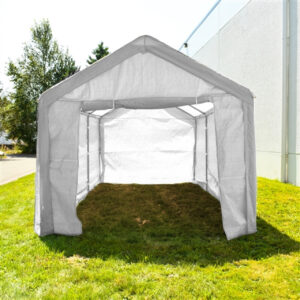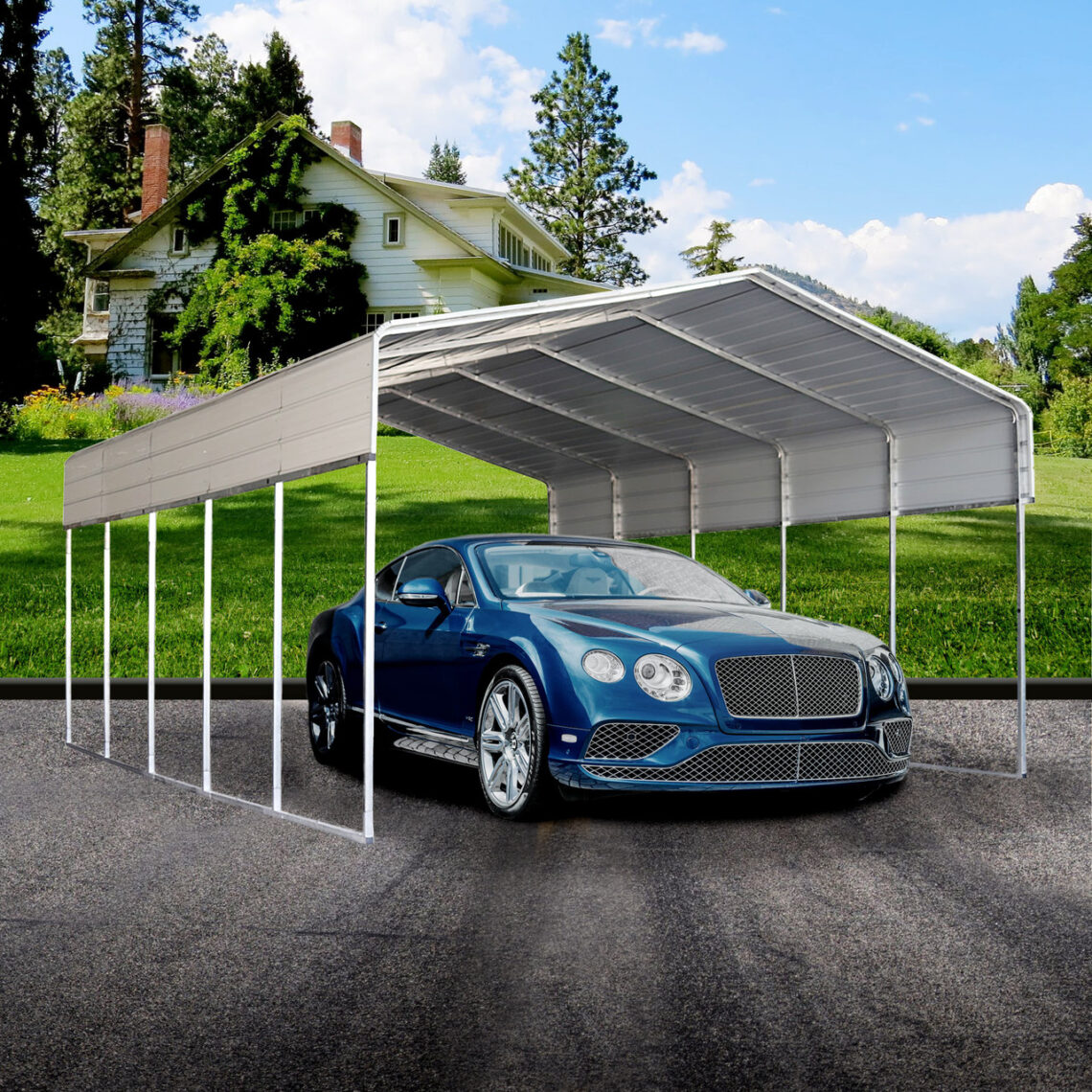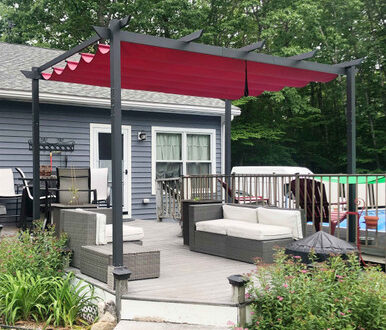You’re thinking about building a freestanding carport to keep your beloved vehicle safe and sound. But there’s something to consider. Before you grab your tools, it’s important to find out if you need a permit for your carport project. The last thing you want is to run into legal troubles or get caught in a storm of building code violations. In this guide, the experts from ALEKO are going to explore the ins and outs of carport permits so you can have all the information you need before making your purchase.
What are Carports?
Before we dive into the permits and regulations, it’s important you first understand what a carport is and how it differs from garages and pergolas. A freestanding carport refers to a structure designed to provide shelter and protection for vehicles while being independent and not attached to any other building. It typically consists of a roof supported by posts or columns, allowing for ample space for parking one or more vehicles. Freestanding carports are versatile structures that can be constructed using various materials such as metal, wood, or even fabric.
They are commonly used to shield cars, motorcycles, boats, or recreational vehicles from the elements, including rain, snow, and sunlight. Additionally, freestanding carports offer the advantage of flexibility in terms of placement and can be installed in residential properties, commercial spaces, or other locations where additional covered parking is needed.
When discussing the differences between carports and garages, it’s important to understand the key differences between the two structures. A garage is a fully enclosed structure with walls, a roof, and a secure entry point such as a door. Garages offer complete protection and security for vehicles, providing a sheltered space that is typically connected to the main dwelling. In contrast, a carport remains open on one or more sides, allowing for easier accessibility and ventilation. A pergola, on the other hand, is primarily an outdoor architectural feature that provides shade and creates an inviting outdoor living space. Unlike carports, pergolas are not intended for vehicle storage and lack the overhead protection that carports offer, making them a great addition when designing a patio or backyard.
Understanding Permits and Building Codes
Before we unravel the mystery of carport permits, let’s take a moment to understand their purpose. Permits and building codes are like the guardians of construction projects, ensuring safety, maintaining property values, and keeping things visually appealing. Every city has its own set of local building codes that dictate the rules for construction and modifications within its limits. These codes cover everything from building dimensions to electrical wiring, plumbing, and even the color of your paint. So, it’s crucial to familiarize yourself with your local building codes before starting any construction work.
The Big Question: Do I Need a Permit For a Freestanding Carport?
Now, let’s tackle the big question: Do you need a permit for a carport? Well, the answer is not as simple as one might think. It depends on various factors such as your location, the size and design of your carport, and whether it will be attached to an existing structure or not.
In general, most cities require a building permit for carport construction. However, some cities may have exemptions for smaller carports or those that are freestanding. This is where you need to reach out to your local city hall or public works office to get the specific requirements for carport permits in your area. Each city has its own rules and regulations to follow, so make sure to gather all the necessary information before getting started.
Determining Whether You Need a Permit for a Carport

Understanding whether a permit is required for your carport construction is essential to ensure compliance with local regulations. Here are some practical steps to help you ascertain if a permit is necessary for your carport project.
Research Local Building Codes
Start by familiarizing yourself with the building codes applicable to your area. These codes, available online or through your local city hall or public works office, outline the specific requirements for carport construction, including setbacks, dimensions, and design considerations.
Contact Local Authorities
When in doubt, it is best to reach out to your local city hall, public works office, or building department for guidance. Speak with knowledgeable staff who can provide accurate information regarding carport permits in your location. Inquire about any exemptions, size limits, or special conditions that may apply to freestanding carports.
Seek Professional Advice
If navigating the permit process seems daunting, consider consulting professionals such as architects, contractors, or building consultants experienced in your area. Their expertise can help you understand and comply with the permit requirements specific to your project. Their guidance can provide valuable insights and ensure your carport adheres to the necessary regulations.
Evaluate Exemptions and Thresholds
Some jurisdictions may have exemptions or thresholds for certain types of carports. It is crucial to review these provisions to determine if your project falls within the exemption criteria. However, keep in mind that even if an exemption applies, it is prudent to verify if any additional conditions need to be met.
Consider Future Modifications
Anticipate potential modifications or expansions you may want to undertake in the future. If your plans may impact the structure or compliance with building codes, it is advisable to obtain a permit initially. This proactive approach ensures that your carport remains compliant as you make future changes, avoiding the need for retroactive permits or adjustments. Plus, carport prices can be a couple hundred dollars. The last thing you would want is to spend all that money for nothing.
Remember, the permit requirements for carports vary by jurisdiction. The steps outlined here provide a general framework to initiate your assessment. However, it is crucial to consult with local authorities and professionals to obtain accurate and specific guidance based on your location and project details.
By following these steps and adhering to the necessary permit requirements, you can embark on your carport construction project confidently, ensuring compliance with local regulations.
Navigating Special Considerations
As you set sail on your carport construction journey, keep an eye out for special considerations that may come your way. Here are a couple of scenarios that require extra attention:
Historic Preservation Zones
If your property falls within a historic preservation zone, you might encounter additional challenges. These areas often have stricter regulations to preserve the unique character of the neighborhood. You may need to obtain special permits or meet specific design requirements to navigate these waters.
Property Line Issues
It’s essential to be mindful of your property lines to avoid any disputes with your neighbors. Ensure that your carport construction stays within the boundaries of your property.
The Importance of Permits
Now, you might be wondering, “Why should I bother with permits? Are they really worth the hassle?” The short answer is yes. Here are a few benefits to consider:
Safety and Compliance
Obtaining a permit ensures that your carport is constructed in compliance with safety standards. It provides a layer of protection against shoddy workmanship, ensuring the structural integrity of your carport.
Property Value Protection
By adhering to local building codes, you’re contributing to the overall preservation of property values in your community. A well-built carport that meets regulations adds value to your home and the surrounding area.
Peace of Mind
Getting a permit offers peace of mind, knowing that you’ve followed the proper procedures and avoided any potential legal troubles. You can rest easy, knowing that your carport project is on the right side of the law.
Final Thoughts: Charting Your Course
Before you buy your carport, check with your local authorities to determine if you need a permit. Familiarize yourself with the local building codes, gather the necessary documents, and navigate the permit process with confidence.
While permits may seem like an extra hurdle to overcome, they come with significant benefits, including safety assurance and property value protection. So, set your compass, chart your course, and embark on your carport construction adventure knowing that you’re sailing in smooth waters. If you want to improve your property security and accessibility, ALEKO offers a variety of gate and fencing solutions. Explore our collection of electric gates for driveways.






